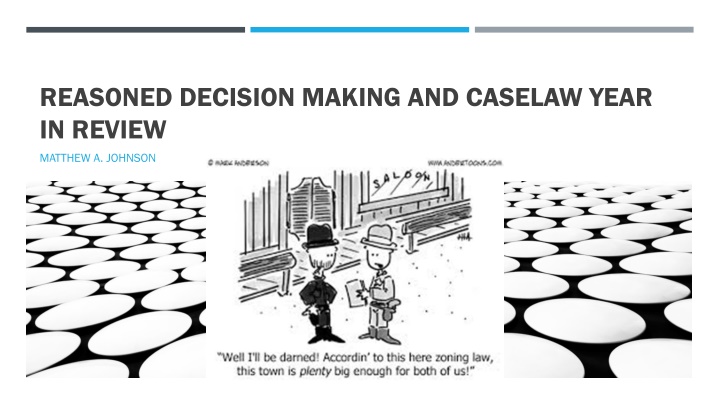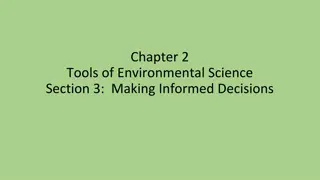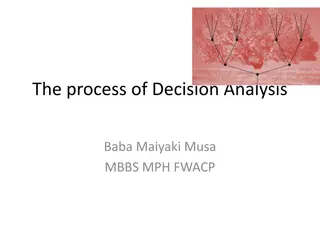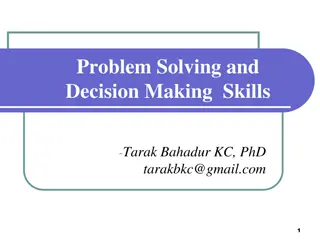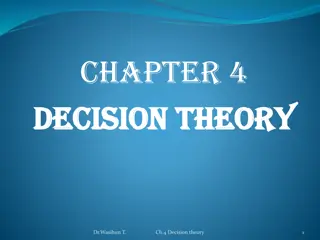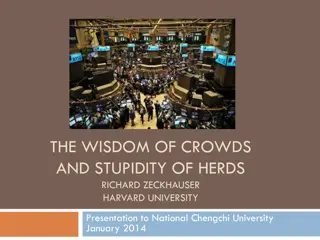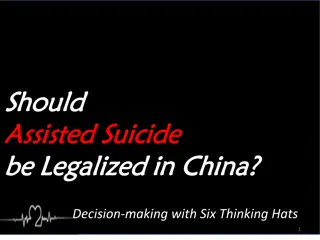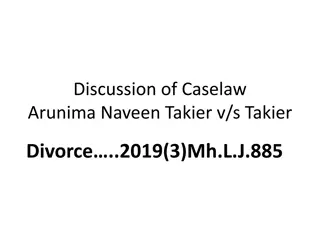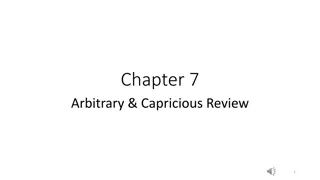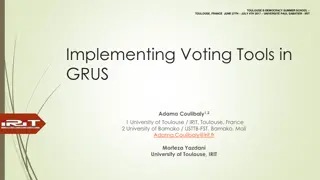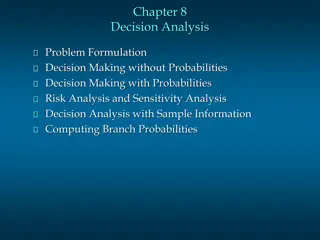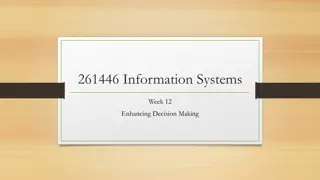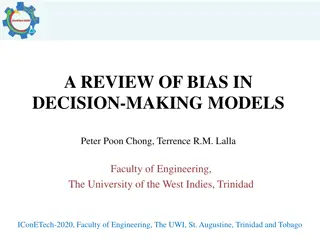Reasoned Decision-making in Caselaw Year Review
Matthew A. Johnson from White Peterson Gigray & Nichols, PA, presents a review of a legal case involving reasoned decision-making and caselaw year in review. The case centers around the North West Neighborhood Association's opposition to land use applications and subsequent legal proceedings. Learn about the process, decisions, and outcomes in this insightful presentation.
Download Presentation

Please find below an Image/Link to download the presentation.
The content on the website is provided AS IS for your information and personal use only. It may not be sold, licensed, or shared on other websites without obtaining consent from the author.If you encounter any issues during the download, it is possible that the publisher has removed the file from their server.
You are allowed to download the files provided on this website for personal or commercial use, subject to the condition that they are used lawfully. All files are the property of their respective owners.
The content on the website is provided AS IS for your information and personal use only. It may not be sold, licensed, or shared on other websites without obtaining consent from the author.
E N D
Presentation Transcript
REASONED DECISION MAKING AND CASELAW YEAR IN REVIEW MATTHEW A. JOHNSON
Matthew Johnson White Peterson Gigray & Nichols, PA. mjohnson@whitepeterson.com (208) 466-9272 www.whitepeterson.com
Disclaimer: In this presentation Im not you or your entity s attorney. This is not legal advice or counsel; it s educational information of a legal nature. CYA (Cover Your . . . .Consult Your Attorney)
Reasoned Decision-making: North West Neighborhood Ass n v. City of Boise Shout out and credit to James Smith, Deputy City Attorney with the City of Boise, and his Winter 2024 IMA Presentation on this case.
Early 2018: 3 land use applications by development team (1) rezone, (2) PUD, and (3) subdivision preliminary plat. Major opposition from NWNA. Court notes rural character and history of the neighborhood is important to many of its residents and that NWNA submits a petition (2500 signatures) in opposition plus oral histories. Planning dept. recommends for approval with conditions to P&Z. P&Z denies PUD and recommends denial of rezone and prelim plat. Fire services concern specifically mentioned as justification.
Immediate appeal by development team of P&Z decision to Boise City Council. (June/July) Court goes into detail on initial two public hearings, particularly fire service discussion. Ultimately, City Council allows for modification of applications to address Council comments/concerns (more open space, less density, phasing, etc.) Leads to October public hearing on revised applications. City Council reverses P&Z denial of PUD and approves rezone and prelim plat. Court notes reasoned statement is merely 1 1/2 pages with other 7 pages just standard conditions. *foreshadowing*
NWNA Request for reconsideration, denied. [Opportunity missed?] NWNA Timely judicial review petition to district court. District court upholds City decision. ID Supreme Court affirms in part; reverses and remands in part. Emphasis on invalidating Council decision and remand for adoption of a reasoned statement.
A Detour into IC 67-6535 specifics: Old IC 67-6535(b): (b) The approval or denial of any application provided for in this chapter shall be in writing and accompanied by a statement in the form of findings of fact and conclusions of law that explain the criteria and standards considered relevant, state the facts relied upon, and explain the justification for the decision based on the criteria, standards and facts set forth. (b) The approval or denial of any application provided for in this chapter shall be in writing and accompanied by a reasoned statement in the form of findings of fact and conclusions of law that explains the criteria and standards considered relevant, states the relevant contested facts relied upon, and explains the justification rationale for the decision based on the criteria, standards and facts set forth applicable provisions of the comprehensive plan, relevant ordinance and statutory provisions, pertinent constitutional principles and factual information contained in the record. 1999 Amendment to IC 67-6535(b) [now IC 67-6535(2)]
IC 67-6535. UPON EXPRESS STANDARDS AND TO BE IN WRITING. (1) The approval or denial of any application required or authorized pursuant to this chapter shall be based upon standards and criteria which shall be set forth in the comprehensive plan, zoning ordinance or other appropriate ordinance or regulation of the city or county. Such approval standards and criteria shall be set forth in express terms in land use ordinances in order that permit applicants, interested residents and decision makers alike may know the express standards that must be met in order to obtain a requested permit or approval. Whenever the nature of any decision standard or criterion allows, the decision shall identify aspects of compliance or noncompliance with relevant approval standards and criteria in the written decision. APPROVAL OR DENIAL OF ANY APPLICATION TO BE BASED
IC 67-6535. UPON EXPRESS STANDARDS AND TO BE IN WRITING. APPROVAL OR DENIAL OF ANY APPLICATION TO BE BASED (2) authorized pursuant to this chapter shall be accompanied by a reasoned statement that explains the criteria and standards considered relevant, states the relevant contested facts relied upon, and explains the rationale for the decision based on the applicable provisions of the comprehensive plan, relevant ordinance and statutory provisions, pertinent constitutional principles and factual information contained in the record. The approval or denial of any application required or in writing and (a) with express approval standards or failure to explain compliance or noncompliance with relevant decision criteria shall be grounds for invalidation of an approved authorization, or denial of same, on appeal. Failure to identify the nature of compliance or noncompliance permit or site-specific
(2) (b) of compliance with the provisions of this section must first seek reconsideration of the final decision within fourteen (14) days. Such written request must identify specific deficiencies in the decision for which reconsideration reconsideration, the decision may be affirmed, reversed or modified after compliance with applicable procedural standards. A written decision shall be provided to the applicant or affected person within sixty (60) days of receipt of the request for reconsideration or the request is deemed denied. A decision shall not be deemed final for purposes of judicial review unless the process required in this subsection has been followed. The twenty- eight (28) day time frame for seeking judicial review is tolled until the date of the written decision regarding reconsideration or the expiration of the sixty (60) day reconsideration period, whichever occurs first. Any applicant or affected person seeking judicial review is sought. Upon
IC 67-6535. UPON EXPRESS STANDARDS AND TO BE IN WRITING. (3) It is the intent of the legislature that decisions made pursuant to this chapter should be founded upon sound reason and practical application of recognized principles of law. In reviewing such decisions, the courts of the state are directed to consider the proceedings as a whole and to evaluate the adequacy of procedures and resultant decisions in light of practical considerations with an emphasis on fundamental fairness and the essentials of reasoned decision making. Only those whose challenge to a decision demonstrates actual harm or violation of fundamental rights, not the mere possibility thereof, shall be entitled to a remedy or reversal of a decision. APPROVAL OR DENIAL OF ANY APPLICATION TO BE BASED
IC 67-6535. UPON EXPRESS STANDARDS AND TO BE IN WRITING. APPROVAL OR DENIAL OF ANY APPLICATION TO BE BASED (3 cont.) Every final decision rendered concerning a site-specific land use request shall provide or be accompanied by notice to the applicant regarding the applicant s right to request a regulatory taking analysis pursuant to section 67-8003, Idaho Code. An applicant denied an application or aggrieved by a final decision concerning matters identified in section 67-6521(1)(a), Idaho Code, may, within twenty-eight (28) days after all remedies have been exhausted under local ordinance, seek judicial review under the procedures provided by chapter 52, title 67, Idaho Code. An appeal shall be from the final decision and not limited to issues raised in the request for reconsideration.
Standard of Review: The actions of a governing board are afforded a strong presumption of validity. Duncan v. State Bd. of Acct., 149 Idaho 1, 3, 232 P.3d 322, 324 (2010). A reviewing court does not substitute its judgment for that of a governing board. Id. Rather, under the Idaho APA, a land use decisionshallbe affirmed unless the reviewing court determines the governing board's findings, inferences, conclusions, or decisions, were: (a) in violation of constitutional or statutory provisions; (b) in excess of the statutory authority of the agency; (c) made upon unlawful procedure; (d) not supported by substantial evidence on the record as a whole; or (e) arbitrary, capricious, or an abuse of discretion. I.C. 67-5279(3) (emphasis added). Importantly, even if a land use decision is made in violation ofsection 67-5279(3), the governing board's decision must be affirmed unless substantial rights of the appellant have been prejudiced.I.C. 67-5279(4). Failure to satisfy LLUPA (IC 67-6535) is likely the (a) exception.
Courts Rationale: Goes back to IC 67-6535 purposes: writing, based on standards/criteria, ability for parties to know/identify standards Jasso Redux: Jasso v. Camas County, 151 Idaho 790 (2011) Conclusory statements versus reasoned explanations Won t infer rationale. To the contrary, the reviewingcourt's responsibility is not to evaluate the sufficiency of the evidence or the soundness of the legal principles upon which a decisionmay have rested; rather, the role of the reviewing court is to evaluate the process by which the decision was reached, considering whether substantial evidence supported the factual findings, and evaluate the soundness of the legal reasoning advanced in support of the decision.
Jasso Redux Brevity is not always a virtue. Why it matters: Due process also requires that parties be afforded a meaningful opportunity for judicial review. If there is to be any meaningful judicial scrutiny of the activities of an administrative agency not for the purpose of substituting judicial judgment for administrative judgment but for the purpose of requiring the administrative agency to demonstrate that it has applied the criteria prescribed by statute and by its own regulations and has not acted arbitrarily or on an ad hoc basis we must require that its order clearly and precisely stated what it found to be the facts and fully explain why those facts lead it to the decision it makes. Brevity is not always a virtue. ... We wish to make it clear that by insisting on adequate findings of fact we are not simply imposing legalistic notions of proper form, or setting an empty exercise for local governments to follow. No particular form is required, and no magic words need be employed. What is needed for adequate judicial review is a clear statement of what, specifically, the decisionmaking body believes, after hearing and considering all the evidence, to be the relevant and important facts upon which its decision is based. Conclusions are not sufficient.
Boises Brevity: After hours of public hearing and deliberation, the Council adopted a cursory one and one- half page reason for decision and seven pages of standard conditions. Largely conclusory, does not identify decision criteria, does not address fire/traffic safety issues raised by NWNA, criteria citation errors, standard of review error between P&Z and Council levels. Cannot engage in meaningful judicial review so therefore violation of NWNA s substantial right to due process. Side note: Court punts on NWNA-argued idea (based on a previous case dissent) that when Council changes decision from P&Z there must be point-by-point explanation of why. ( We will leave that question for another day. ) *foreshadowing?* Result: Remand for adoption of reasoned statement. Court specifically points out no further process/public hearing specifically required (though may be opted into).
Other government agency referral issue (NWNA argument) failed to preserve Other unlawful procedure arguments (NWNA) no prejudice to substantial rights of NWNA [Court cites to IDAPA IC 67-5279(4), but arguably could be actual harm/violation of fundamental rights under IC 67-6535(3)] No party gets fees, though NWNA gets costs of appeal.
PIVOT TO THE PRACTICAL POSSIBLE TAKE AWAYS FOR BETTER REASONED STATEMENTS Beware the CONCLUSORY! There may be virtue to being verbose, loquacious, long-winded, and garrulous? Procedural background versus fact-finding. Recitation of steps versus weighing of disputed facts. Be careful about just reciting testimony. Include reasons for changes if differing P&Z/Council decisions? The struggle is real; show it! Distinguish undisputed and disputed facts/issues. (Undisputed may require less rationale. If it s disputed though, the body better address it, weigh it, and make a reasoned finding. E.g. Boise perceived failure to address fire service issue.) Consider questioning on presentations of facts to help ascribe weight. (Press commenters to provide reasoning rather than just conclusions, e.g. traffic is bad versus actual traffic study. Generalized grievances aren t likely enough, but make sure you identify that.)
PIVOT TO THE PRACTICAL POSSIBLE TAKE AWAYS FOR BETTER REASONED STATEMENTS May need to press decisionmakers for more direct weighing of disputes and in-real-time determinations (expect some reluctance). Consider laying decision out up front. Decide and then justify, rather than building to conclusion. Puts all the rationale in context from start. Caution about Comp Plan language that reads like mandates/requirements versus guidance. Caselaw is the Comp Plan is merely a guide. Magic words? Time to drop FCO/FCR and embrace the RSD! Relevant contested facts Relevant criteria and standards Applicable provisions Rationale Totality of the Record [IC 67-6535(3)]. There may be saving grace in the rest of the Record? Manage the Record well. Consider incorporating into RSD as references to show the whole (witnesses, exhibits, affidavits). While the Board of Commissioners would be better served by more specifically and extensively articulating its findings of fact and conclusions, the required information can be found in the record produced during the application process. This is in accord with I.C. 67-6535(c), which requires a reviewing court to consider the whole process. Evans v. Teton Cty., 139 Idaho at 71
PIVOT TO THE PRACTICAL POSSIBLE TAKE AWAYS FOR BETTER REASONED STATEMENTS Don t forget IC 67-6519(5), particularly (c) if denial: (5) commission grants or denies an application, it shall specify: (a) The ordinance and standards used in evaluating the application; (b) The reasons for approval or denial; and (c) The actions, if any, that approval. Whenever a governing board or zoning or planning and zoning the applicant could take to obtain Consider including others notices of rights (administrative appeal, reconsideration, regulatory takings analyses) Perspective: Put on your fancy wig and write the judge s decision for them in advance. Less quasi; more judicial. CYA Consult Your Attorney.
Renaissance Project Development v. Twin Falls County, 173 Idaho 498 (2024) Dispute over County denial of preliminary plat application for subsequent phases of a subdivision. Core issue was lack of 2nd egress from subdivision for fire safety purposes. Court discusses County s reasoned statement specifically inclusion of statements that demonstrate the PZC and the County understood that their duties in reviewing the Application required careful consideration of the health and safety concerns raised by the public, and they explain the basis for the denial. Note despite lacking some specific code citations (generally enough identified with references to Titles). Note Court rejects argument that 2nd egress has to be specifically stated in Code. Court less favorable on written decision s handling of traffic concerns: mere recitations of the record rather than resolution of contradictory information presented at the hearing. Finding of fact: calls for proof. Ex. Light is red or green (proof to find fact despite different assertions). Explain why find something is true/proved. Failure to address conformance with Comp Plan but doesn t prejudice substantial right Issues, but County wins judicial review petition dismissed.
Bracken v. City of Ketchum, 172 Idaho 803 (2023) CUP application for gas station submitted and denied by P&Z; 2nd CUP application submitted. Dispute about substantially similar, which would have required one-year wait per city ordinance. While administrative appeal on that issue, City also processes and passes ordinance amending so gas stations are not an allowed use (even by CUP) along Main St. P&Z reverses Administrator determination and finds 2nd application has material changes. Administrator tells applicant to re-submit 2nd Application. Applicant does not re-submit until 5 months later; Administrator denies due to new ordinance not allowing gas stations. Issues about timing of proceedings, statements made. Bracken files Notice of Tort Claim without any further proceedings by City. Messy case ultimately 10 different counts, all dismissed for various reasons upon summary judgment at district court level. ID Supreme Court affirms district court on all parts except one claim: tortious interference with economic expectancy. Court widens exception to requirement to exhaust administrative remedies due to unique circumstances of case.
Sullivan v. Blaine County, September 25, 2024 Decision Dispute over CUP and modification of CUP. Case hinges on whether neighbor appellant has prejudice to substantial rights. Not found and her case is dismissed. Good case for some analysis on factors/comparisons for what may constitute interference with use and enjoyment of property to extent necessary to be prejudice to substantial right. Comparison of two other cases reaching different conclusions, and distinctions as to why. Practical tip: consideration and inclusion of conditions to mitigate adverse impacts seems to be a key factor in the Court s distinction above.
Reese v. City of Blackfoot, 172 Idaho 164 (2023) Neighbors bring judicial review action against City s approval of a PUD. Courts find that City did violate its own zoning code (noncompliance with density requirements), but that failure by Reeses to show prejudice to substantial rights. So City still wins. Opinion distinguishes the following: All parties have a substantial right to a reasonably fair decision-making process. Applicants have a substantial right to adjudication by applying correct legal standards. Opposing parties have to show more than legal error jeopardy of suffering substantial harm . . . such as a reduction in the opponent s land value or interference with his or her use or ownership of the land. Must show (not just allege) harm to rights.
US Supreme Court: Sheetz v. County of El Dorado Sheetz v. County of El Dorado, California,144 S. Ct. 893 (2024) County charges traffic impact fee associated with residential building permit. Challenged as an exaction in violation of Takings Clause. Nollan/Dolan test: essential nexus of condition on development to government s land-use interest; furthering stated purpose, not leveraging permitting monopoly to exact. rough proportionality of payment/giving to mitigation of harm of impacts Defense: Legislative permit condition (not ad hoc administrative basis), so Nollan/Dolan don t apply. CA Court of Appeals agreed. Court: Nope, Nollan/Dolan applies to legislative acts as well as administrative. Remanded back to state courts for other issues, including whether individualized determination on legislative fee is necessary. See also 9th Circuit case Ballinger v. City of Oakland, 24 F.4th 1287 (9th Cir. 2022)
Hill v. Blaine County, 550 P.3rd 264 (June 2024) Appeal related to encroachment/access permit denial, but underlying issue is really question of County s action on validating a road (or not). Good case for some overview on road validation process and meaning/purpose of validation (accepting jurisdiction).
Matthew Johnson White Peterson Gigray & Nichols, PA. mjohnson@whitepeterson.com (208) 466-9272 www.whitepeterson.com
